Rouse and her husband Don work a 40,000-acre ranch running heifers on the Conchas River. When the couple moved in two years ago, they got the 200-year-old adobe ranch house and the phone. A few days in, the phone rang. Expecting the former tenant, the caller needed a horse trained. They got Brittany. Her clientele has grown from there. The colts come from Clayton and Roy, Ft. Sumner and Tucumcari, Santa Rosa and Santa Fe.
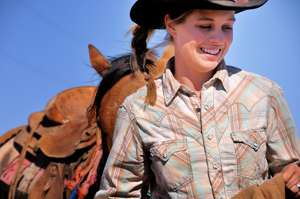 She didn’t come to this directly. “As a little girl, I dreamed, I prayed, I begged for a horse. Every night, every day, ten times a day. My dad, as a young kid, was on a farm and he just didn’t see them as anything but stinky and messy and work. So I didn’t get one. And you kinda grow up and you leave those child thoughts behind.”
She didn’t come to this directly. “As a little girl, I dreamed, I prayed, I begged for a horse. Every night, every day, ten times a day. My dad, as a young kid, was on a farm and he just didn’t see them as anything but stinky and messy and work. So I didn’t get one. And you kinda grow up and you leave those child thoughts behind.”
Five years ago she was working for an Amarillo grocery store – bookkeeping, receiving, running the front end – and Don was a customer. “I was 22 when I met Don. He put me on a horse and I hated it! I absolutely hated riding horses,” she laughs. “It was the most uncomfortable thing in the world. But the more I did it, I got a little more accustomed to it. It didn’t hurt as bad.
“The opportunity came up for me to go to work with Don and be making more money in less time, so I took it. Being forced into it, I started loving it. I didn’t know that this was my life, until I met Don. Now I can’t go back to a desk job.”
By the time they moved to New Mexico and that phone rang two years ago, Brittany had done a good deal of colt training for Don. “It’s a lot like kids,” she says, thinking of her daughter Kourtnie, 7, and son Kyle, 5. “I’ve watched Don, I’ve watched other people, but when it comes down to it, it takes common sense. Just like with a kid, what works for one isn’t going to work for another. You’ve got to flexible. Sometimes you come up with really creative ways of getting through to them.”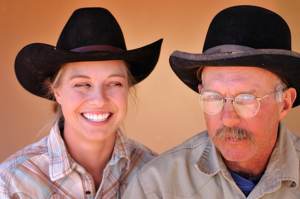
Don has his hands – and days and nights – full running heifers. Brittany has made the colt training operation her own, though they help each other when needed. “Any colts we get,” says Don, “she does all the ground work. She gets them all ready. I don’t have the time. This job’s 24-7. If it wasn’t for her, I’d leave. It’s gotta be both of us but she gets a lot of the crap jobs and when I’m in a wreck somewhere, if I can call home, I’ll call her and say, honey, catch a horse, I need help, and she just drops whatever she’s doing and comes to help me. She’s saved my butt a lot.”
Asked to explain Brittany’s comfort and confidence after only five years around horses, Don explains, “She’s been totally immersed in it. It’s not a weekend deal, it’s every day. When somebody sends us a horse, when they get it back they can ride it, it’ll get into the trailer, it can have a rope swung on it – it’s a good-to-go horse.”
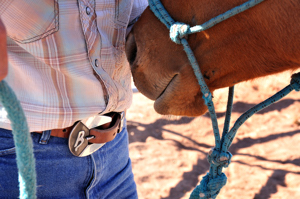
Brittany books each colt for 30 days of training, though it may take a little longer to get those 30 days in. “The winds are too intense sometimes. You want to set them up for success so you don’t want to take a new situation and add scary to it.” She’ll spend 2-3 hours a day with a colt, depending on its age and maturity, and 6-10 hours training colts in a day. “I don’t keep more than two outside colts, or three, because you just don’t get to give them the attention that they need if you start getting too many.
“The first 30 days they’re not going to get many specifics. They get a good base and start showing you what their potentials are. They might be good with cows, or with roping, or barrels – they’re just like people, they have their specialties just like we do. Most owners just want the crazy out of them. If they want more, I’m happy to do another 30 days. You’re still building on the base, but you’re giving more exposure to it. The next step is actually starting to be useful, and for some it’s going to be more useful than others.”
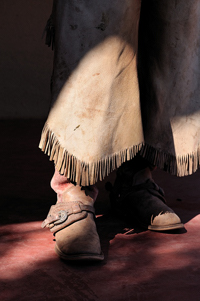
She and Don have created many of their own training aids. Those pots and pans dangling from the saddle horn of the young dun teach him to not react to everything. The colt can hear, feel, and see them; he learns to ignore them. A heavy ball and chain – a wedding gift to Don from Brittany’s brother – is used to train a high-headed horse. Don makes most of their riggings, along with the family’s spurs and buckles.
“We make what we need," Brittany continues. “Our opinion is, if it works, great. We’re not very shiny people.”
“We don’t use bits on young colts,” Brittany explains. “They’re already dealing with teething and the like. We start them on the 3-ringer, then move to the beetle hack (both made by Don). Finally, some will go to a bit for a spell, but with our own horses they go back to the hackamore. It’s about getting into their heads instead of their mouths. We use neck reining: first press the foot, then feel the offside rein. Then, if they don’t go with you, then they get the pull.”
One of their most useful inventions is the purple cow: welded from heavy 2” metal pipe and painted purple, it has a pair of horns, rear “feet” just off the ground, and its weight skids along when pulled by a colt. “You can drag it and it starts helping them to log stuff, and to be able to drag in a branding pen,” Brittany says. “You can rope it and it helps them start learning where their spot is to rope. It just gives them exposure to messing with something. We have a tire, also, that they learn to log to. I use the purple cow because you can tie on to it in a setting that’s not crazy, that’s not nuts, that they can just learn and that’s the only objective they have. You can teach them to hold the rope and keep their head still. That way, when you get out where it counts, they know what you’re expecting.
“We love on them, but when we’re training and working them, they’re a tool. Every foot has a different brain. Each side has a different brain.” Watching her work a new colt in the round pen, the overwhelming sense one gets is of a mother and child – the kind of mother we’d all hope to have. The love shows when she talks about her “babies”. “Cayenne can do anything. He’d be the high school athlete with a letter on his jacket for every sport. Moop, short for Moopalusa, is a mutt, no papers, but one of Don’s favorites. She’s nutty. She takes care of Don. She’d die for him, something you get more in mares than in geldings. She isn’t as eloquent, but she could take you around the whole ranch and never get tired on you.
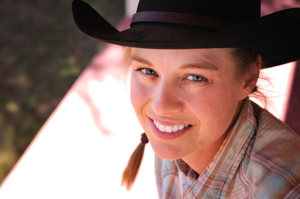
“Wild Thing – short for his full name Chief Wild Thing of the Punkass Tribe – he’s my baby. He got his name from his attitude. He was a mean little baby. His mom is good-natured; she’s the one my son rides. Wild Thing’s a 60-day pony, at the end of his second 30 days, so he’s been saddled 60 times. He is going to be a very level-headed, very bomb-proof pony.” She and Don call all their horses ponies, all the colts babies.
“Every one of our horses has helped train a colt. Having a seasoned horse in with them helps.” Looking them over, talking about them, her love and pride shows. And then she sums it up herself. “Our own horses speak for what we can make.”
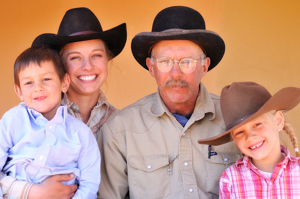
Read Don's poem, Welcome to Cabra
©2009 Tim Keller